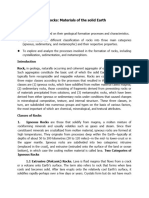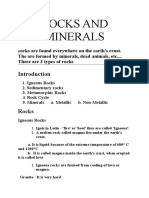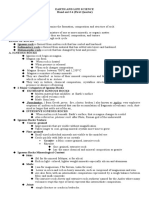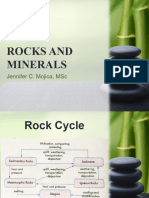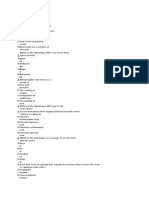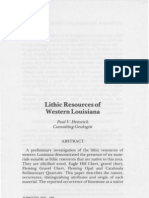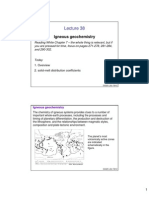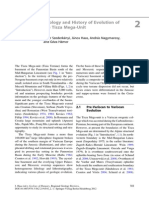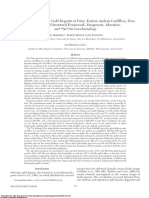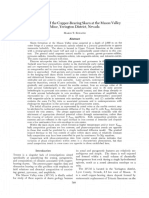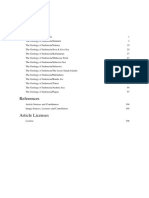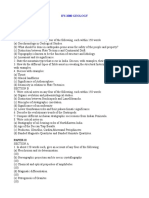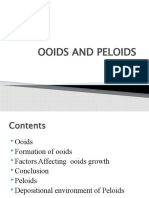Kinds of Rocks Sedimentary Rocks
Kinds of Rocks Sedimentary Rocks
Uploaded by
lhors17Copyright:
Available Formats
Kinds of Rocks Sedimentary Rocks
Kinds of Rocks Sedimentary Rocks
Uploaded by
lhors17Original Description:
Original Title
Copyright
Available Formats
Share this document
Did you find this document useful?
Is this content inappropriate?
Copyright:
Available Formats
Kinds of Rocks Sedimentary Rocks
Kinds of Rocks Sedimentary Rocks
Uploaded by
lhors17Copyright:
Available Formats
KINDS OF ROCKS SEDIMENTARY ROCKS
Igneous rocks are made from lava or magma. Lava and magma are made of hot, melted minerals. Lava is found on or near the Earths surface. Magma is found far beneath the Earths surface.
Extrusive igneous rocks are made from lava that cooled quickly. Extrusive rocks generally have either no crystals or very tiny crystals. Intrusive igneous rocks are made from slow-cooling magma. Intrusive rocks have large crystals. pumice, basalt, obsidian, scoria, rhyolite, andesite Intrusive igneous rocks: granite, gabbro, diorite
COAL: A sedimentary rock, formed from decayed plants, is mainly used in power plants to make electricity.
LIMESTONE: A sedimentary rock, it is used mainly in the manufacture of Portland cement, the production of lime, manufacture of paper, petrochemicals, insecticides, linoleum, fiberglass, glass, carpet backing and as the coating on many types of chewing gum.
CONGLOMERATE: A sedimentary rock with a variable hardness, consisted of rounded or angular rock or mineral fragments cemented by silica, lime, iron oxide, etc. Usually found in mostly thick, crudely stratified layers. Used in the construction industry.\
SANDSTONE: A sedimentary rock more or less rounded. Generally thick-bedded, varicolored, rough feel due to uneven surface produced by breaking around the grains. Used principally for construction, it is easy to work, the red-brown sandstone of Triassic age, better known as "brownstone," has been used in many eastern cities.
Shale is used as a raw material for making many types of brick, tile, pipe, pottery and other manufactured products. Brick and tile are some of the most extensively used and highly desired materials for building homes.
IGNEOUS ROCKS
Igneous rocks are made from lava or magma. Lava and magma are made of hot, melted minerals. Lava is found on or near the Earths surface. Magma is found far beneath the Earths surface.
Extrusive igneous rocks are made from lava that cooled quickly. Extrusive rocks generally have either no crystals or very tiny crystals. Intrusive igneous rocks are made from slow-cooling magma. Intrusive rocks have large crystals. pumice, basalt, obsidian, scoria, rhyolite, andesite Intrusive igneous rocks: granite, gabbro, diorite
Granite has been used for thousands of years in both interior and exterior applications. Rough-cut and polished granite is used in buildings, bridges, paving, monuments and many other exterior projects. Indoors, polished granite slabs and tiles are used in countertops, tile floors, stair treads and many other practical and decorative features.
....CONT. (Igneous rocks)
PUMICE: An igneous-volcanic rock, it is a porous, brittle variety of rhyolite and is light enough to float. It is formed when magma of granite composition erupts at the earths surface or intrudes the crust at shallow depths. It is used as an abrasive material in hand soaps, emery boards, etc.
GABBRO: An igneous-plutonic rock, generally massive, but may exhibit a layered structure produced by successive layers of different mineral composition. It is widely used as crushed stone for concrete aggregate, road metal, railroad ballast, etc. Smaller quantities are cut and polished for dimension stone (called black granite).
BASALT: An igneous volcanic rock, dark gray to black, it is the volcanic equivalent of plutonic gabbro and is rich in ferromagnesian minerals. Basalt can be used in aggregate.
METAMORPHIC ROCKS
Metamorphic rocks are made from older rocks, either igneous or sedimentary. These rocks are changed by great heat and/or pressure deep beneath the earths surface. The heat and pressure makes crystals in the rock. If the rock already has crystals, the heat makes the c rystals larger. Sometimes the pressure flattens the crystals into layers.
SCHIST: A metamorphic uneven-granular, medium to coarse grained, crystalline with prominent parallel mineral orientation. Goes from silvery white to all shades of gray with yellow to brown tones depending on the mineral concentration. Some schists have graphite and some are used as building stones.
GNEISS: A metamorphic uneven granular medium to coarse grained crystalline with more or less parallel mineral orientation. Colors are too variable to be of diagnostic value. Due to physical and chemical similarity between many gneisses and plutonic igneous rocks some are used as building stones and other structural purposes.
QUARTZITE: A metamorphic or sedimentary rock with crystalline texture, consists of rounded quartz grains cemented by crystalline quartz, generally white, light gray or yellow to brown. Same uses as sandstone.
MARBLE: A metamorphic even-granular grain to medium grained and may be uneven granular and coarse grained in calc-silicate rock. The normal color is white but accessory minerals act as coloring agents and may produce a variety of colors. Depending upon its purity, texture, color and marbled pattern it is quarried for use as dimension stone for statuary, architectural and ornamental purposes. Dolomite rich marble may be a source for magnesium and is used as an ingredient in the manufacture of refracting materials.
You might also like
- Sedimentary Rocks CrosswordDocument1 pageSedimentary Rocks Crosswordapi-660734816No ratings yet
- The Bouma SequenceDocument21 pagesThe Bouma SequenceUbaid Asif0% (1)
- In Power Plants To Make ElectricityDocument8 pagesIn Power Plants To Make Electricityanon_707034465No ratings yet
- StonesDocument111 pagesStonesSantosh Kumar MNo ratings yet
- حجارةDocument5 pagesحجارةDAFNSHI AMNo ratings yet
- CE 212 - Rock CycleDocument18 pagesCE 212 - Rock CycleJulius CodiamatNo ratings yet
- Week 2 (Civil Engineering Material)Document45 pagesWeek 2 (Civil Engineering Material)abdul raoufNo ratings yet
- Building StonesDocument27 pagesBuilding StonesJeric LaureanoNo ratings yet
- Igneous RocksDocument12 pagesIgneous RocksGlendel CarmenNo ratings yet
- Types of Rocks AND ITS ExampleDocument18 pagesTypes of Rocks AND ITS ExampleGerlie ManiquizNo ratings yet
- Group 2 Rocks Handouts 1Document22 pagesGroup 2 Rocks Handouts 1Liezel VillaruzNo ratings yet
- Igneous RockDocument20 pagesIgneous Rockchloe luresNo ratings yet
- Stone and Concrete MasonryDocument80 pagesStone and Concrete MasonryMaria VillanuevaNo ratings yet
- Stone: DEFINITION-The Process of Taking Out Stones From Natural Rock Beds Is Known As TheDocument11 pagesStone: DEFINITION-The Process of Taking Out Stones From Natural Rock Beds Is Known As TheAmit KumawatNo ratings yet
- Materia Stone Cha 2Document6 pagesMateria Stone Cha 2Yosef KirosNo ratings yet
- Building StonesDocument75 pagesBuilding StonesXhorxhIsm100% (1)
- Building Material: Prepared By: K. S. PatelDocument4 pagesBuilding Material: Prepared By: K. S. PatelkamalnitrrNo ratings yet
- 2020 BUILDING TECHNOLOGY 1 Module 1 Lecture 2a - Stone and Concrete MasonryDocument41 pages2020 BUILDING TECHNOLOGY 1 Module 1 Lecture 2a - Stone and Concrete Masonrylia immie rigoNo ratings yet
- Report-Natural StonesDocument12 pagesReport-Natural Stonesdrushtibhandari69No ratings yet
- Marble and GraniteDocument32 pagesMarble and GraniteJamesNo ratings yet
- Geology DeLunaDocument40 pagesGeology DeLunadeluna.jerremieNo ratings yet
- Stone: As A Building Construction MaterialDocument22 pagesStone: As A Building Construction Materialshersinghb12No ratings yet
- PetrologyDocument5 pagesPetrologyMar PalmaNo ratings yet
- Exp SC 5 - Chapter 10Document10 pagesExp SC 5 - Chapter 10megamind publicationNo ratings yet
- Rocks and MineralsDocument5 pagesRocks and MineralsAditi AherNo ratings yet
- Types of RocksDocument6 pagesTypes of RocksAlthea Joy SalaanNo ratings yet
- Marble and GraniteDocument32 pagesMarble and GraniteMohammed Sameer jNo ratings yet
- Stone As A Building Material PDFDocument28 pagesStone As A Building Material PDFAR Bilal Ansari100% (1)
- StonesDocument23 pagesStonesSaumya ShrutiNo ratings yet
- BT 1 M03 - Rock Stone Masonry EditedDocument29 pagesBT 1 M03 - Rock Stone Masonry EditedReyvel Sapaden CorcueraNo ratings yet
- E & LS Chapter 3Document130 pagesE & LS Chapter 3jerelyn ermeNo ratings yet
- Building MaterialsDocument5 pagesBuilding MaterialsasdasdadasaNo ratings yet
- Rocks and MineralsDocument15 pagesRocks and Mineralsdwayne dixonNo ratings yet
- CEMC Module 3Document67 pagesCEMC Module 3Biswajit SamalNo ratings yet
- Igneous RocksDocument11 pagesIgneous RocksPriyanka JNo ratings yet
- Rocks and MineralsDocument6 pagesRocks and Mineralsrosana f.rodriguezNo ratings yet
- BUILDING TECH 1 Lect 3 MASONRY - Building StonesDocument10 pagesBUILDING TECH 1 Lect 3 MASONRY - Building StonesElyzaGutierrezCabacesNo ratings yet
- Marbleand GraniteDocument32 pagesMarbleand GraniteEyob TadesseNo ratings yet
- Non Metallic Mineral ResourcesDocument3 pagesNon Metallic Mineral ResourcesadekunleNo ratings yet
- Building StoneDocument43 pagesBuilding Stonejohnvincent.lagmanNo ratings yet
- Midory Martínez Canto Rossenyth Ortiz Domínguez Ricardo Acosta TenorioDocument21 pagesMidory Martínez Canto Rossenyth Ortiz Domínguez Ricardo Acosta TenorioMidori McNo ratings yet
- Chapter 3-3Document24 pagesChapter 3-3Solomon DesalegnNo ratings yet
- bCHApter 4Document8 pagesbCHApter 4Sani MohammedNo ratings yet
- Rock SortDocument1 pageRock Sortapi-306447547No ratings yet
- Volcanoes and Plutons: By: Group 2Document54 pagesVolcanoes and Plutons: By: Group 2Anonymous fr268tGNo ratings yet
- Rocks and Minerals 1Document24 pagesRocks and Minerals 1businechelsea7No ratings yet
- Geo 222 Groupactivity 1 Bsce 2e Group 3Document8 pagesGeo 222 Groupactivity 1 Bsce 2e Group 3YUMUL, ANGELICA. CRUZNo ratings yet
- Stones PDFDocument14 pagesStones PDFTZShengNo ratings yet
- Form One GeographyDocument4 pagesForm One GeographyAfriyie GyimahNo ratings yet
- Rock Formation & MineralsDocument24 pagesRock Formation & Mineralsamanamu436No ratings yet
- Building StonesDocument21 pagesBuilding StonesPau AbesNo ratings yet
- 3 Rocks Igneous RocksDocument20 pages3 Rocks Igneous RocksYounas BilalNo ratings yet
- Earth Materials and ProcessesDocument60 pagesEarth Materials and ProcessesZarlene SierraNo ratings yet
- ROCKSDocument3 pagesROCKSDon Henessy DavidNo ratings yet
- CENG 22 - PetrologyDocument139 pagesCENG 22 - PetrologyArya BebeNo ratings yet
- Earth Materials and ProcessesDocument66 pagesEarth Materials and ProcessesNaruto UzumakiNo ratings yet
- ARTB01: Building Stones, Gypsum and Limes Wood and Wood ProductsDocument26 pagesARTB01: Building Stones, Gypsum and Limes Wood and Wood ProductsImae BalijoNo ratings yet
- Stone U1Document45 pagesStone U1mgsvettyNo ratings yet
- Rocks and What We Know About Them - Geology for Kids | Children's Earth Sciences BooksFrom EverandRocks and What We Know About Them - Geology for Kids | Children's Earth Sciences BooksNo ratings yet
- Crain's Petrophysical Handbook - Visual Analysis of Lithology - MineralogyDocument11 pagesCrain's Petrophysical Handbook - Visual Analysis of Lithology - Mineralogyzeolite_naturalNo ratings yet
- Grade 11 - w2 - Earth and Life ScienceDocument7 pagesGrade 11 - w2 - Earth and Life ScienceLeslie MermeloNo ratings yet
- Whitter Field EORDocument88 pagesWhitter Field EORengye7iaNo ratings yet
- Revision Sheet RocksDocument3 pagesRevision Sheet Rocksmofid monirNo ratings yet
- Lithic Resources of Western LouisianaDocument26 pagesLithic Resources of Western LouisianaetchplainNo ratings yet
- Lect 38Document16 pagesLect 38Laura JohnsonNo ratings yet
- Conglomerate and Breccia Description 2021Document12 pagesConglomerate and Breccia Description 2021SuzanneTeuscherNo ratings yet
- AntaminaDocument15 pagesAntaminaEdilberAntonyChipanaPariNo ratings yet
- Dantas Et Al 2013Document37 pagesDantas Et Al 2013Dhulya RochaNo ratings yet
- Earth and Life Science: Quarter 1 - Module 7: MagmatismDocument26 pagesEarth and Life Science: Quarter 1 - Module 7: MagmatismRonnie Dalgo50% (2)
- ICES 2019 Book of Abstracts 1 PDFDocument237 pagesICES 2019 Book of Abstracts 1 PDFilmiNo ratings yet
- Send Perhitungan Ritase Driver 2018-08Document19 pagesSend Perhitungan Ritase Driver 2018-08Asep KingNo ratings yet
- CV GsiDocument1 pageCV GsiSubham DuttaNo ratings yet
- Geology of HungaryDocument47 pagesGeology of HungaryRodrigo GomesNo ratings yet
- Geologic Materials: Rock (Geology) Rock CycleDocument2 pagesGeologic Materials: Rock (Geology) Rock CycleJohn Kenneth BentirNo ratings yet
- Arnold & Griffin - Intrusions & PCD Prospects, Star MTNS., PNG - !978Document11 pagesArnold & Griffin - Intrusions & PCD Prospects, Star MTNS., PNG - !978Hanistyas WidoretnoNo ratings yet
- Research ProposalDocument4 pagesResearch ProposalMuhammad Rizwan100% (1)
- Rock Cycle Short EssayDocument7 pagesRock Cycle Short EssayJay-MarNo ratings yet
- Carboniferous Orogenic Gold Deposits at Pataz, Eastern Andean Cordillera, Peru: Geological and Structural Framework, Paragenesis, Alteration, and Ar/ Ar GeochronologyDocument40 pagesCarboniferous Orogenic Gold Deposits at Pataz, Eastern Andean Cordillera, Peru: Geological and Structural Framework, Paragenesis, Alteration, and Ar/ Ar GeochronologyIván IslaNo ratings yet
- Einaudi-1977-Mason Valley Mine p0769-p0795Document27 pagesEinaudi-1977-Mason Valley Mine p0769-p0795Oppc DuckNo ratings yet
- The Age of Orrorin Tugenensis, An Early Hominid From The Tugen Hills, KenyaDocument11 pagesThe Age of Orrorin Tugenensis, An Early Hominid From The Tugen Hills, KenyaFayy Jacötey de BönesNo ratings yet
- Collection 2Document107 pagesCollection 2azra syafiraNo ratings yet
- (WWW - Entrance-Exam - Net) - IFS Geology (Paper I) Sample Paper 1 PDFDocument2 pages(WWW - Entrance-Exam - Net) - IFS Geology (Paper I) Sample Paper 1 PDFPawan Kumar AcharyaNo ratings yet
- Ooids and PeloidsDocument15 pagesOoids and PeloidsMuhammad WaqasNo ratings yet
- 1669.fullmineralized Veins and Breccias of The Cripple Creek District, ColoradoDocument20 pages1669.fullmineralized Veins and Breccias of The Cripple Creek District, ColoradomiarangocNo ratings yet
- Volumen 2 Amaga-Cauca-Patia BasinsDocument102 pagesVolumen 2 Amaga-Cauca-Patia BasinsEdwin Alexander Amado Prieto100% (1)
- 3 Abstrak PDFDocument1 page3 Abstrak PDFMarkusNo ratings yet
- Classifications of Rock PropertiesDocument5 pagesClassifications of Rock PropertiesAlwin AntonyNo ratings yet











